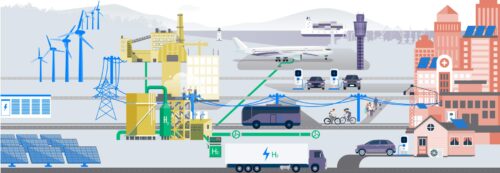
Picturing a Clean Energy Future Just Got Easier
New graphics show sector-by-sector opportunities, federal investment potential, and the real human benefits we can access if states act fast.
Our future will be powered by clean energy. Our economy is already moving towards this — rapidly. These changes provide enormous opportunities for economic development and improvements in public health and safety, among other benefits.
New graphics from RMI show sector-by-sector opportunities, federal investment potential, and the real human benefits we can access if states act fast.
Visualizing the pieces of a clean energy future
The growth of clean energy technologies can help states strengthen their economies, improve the health of their residents, reduce air pollution, and make buildings safer and more resilient. For example, clean vehicle and battery manufacturing are spurring economic development and job growth across the country. Heat pumps are making buildings healthier places to work and live by reducing indoor air pollution. Bringing electrification and energy efficiency to industry improves outdoor air quality and benefits entire communities. Making homes better insulated doesn’t just lower energy bills; it also increases home resilience and safety during increasingly frequent extreme weather events.
While large businesses are focusing on this tremendous opportunity, many people often miss the huge potential this represents for thousands of small businesses: auto dealers, repair shops, home contractors, parts suppliers, and more. Additionally, people in large industries — such as shipping, manufacturing, and aviation — will also see new opportunities.
To help states focus their efforts on achieving these benefits, our State Solutions Graphics illustrate the sector-by-sector parts of a clean, prosperous future for each state. They quantify the potential magnitude of each component and demonstrate how these parts fit together. They also show what these parts can achieve if deployed together and at scale: new clean economy jobs, money saved from avoided deaths, reduced asthma attacks, and potential federal investment.
Now we can see what an economy looks like when it’s powered entirely by clean energy. In transportation, for example, there will be more electric cars and charging infrastructure; clean fuels will power planes, trucks, and ships; and communities will be more walkable, bikeable, and transit-friendly. This system will rely on an electricity grid powered by renewable energy, green hydrogen produced by industry, and buildings with EV charging stations. The opportunities for a thriving clean energy future are abundant — and interconnected.
Realizing this vision requires state policy
The essential technologies are ready, but deploying them in full requires rapid, robust, and sustained policy support. With billions of federal dollars on the table through laws like the Inflation Reduction Act, it’s up to the states (and local communities) to leverage key opportunities. Indeed, state decisions will determine the ultimate size of federal investment, since many of the tax credits in the Inflation Reduction Act are uncapped. In other words, the more — and the faster — that states act, the more they can reap.
The opportunities are profuse, but states need not feel overwhelmed as they plan their clean energy future. They can make great strides with a few well-chosen steps. RMI analysis suggests that by implementing just five key policies, states can get two-thirds of the way to a clean energy future:
- Investing in clean electricity infrastructure
- Supporting upgrades in buildings
- Laying out the welcome mat for electric vehicles
- Advancing efficiency and electrification in industry
- Slashing methane pollution
In some states, even one action can make a huge difference. For example, implementing the Clean Energy Framework under consideration in Michigan could single-handedly get the state 30 percent of the way further toward its 2030 goals than current policy.
States across the country — from Iowa to Kansas to Louisiana — are already experiencing massive benefits from the clean energy transition. For example, Ohio’s clean energy economy continues to grow, with jobs on the rise, electric vehicle and battery projects announced one on top of the other, and an estimated $12.8 billion in federal investment from the IRA expected to flow to the state by 2030. States with significant rural and industrial communities often stand to benefit the most (per capita) from federal clean energy investments. State policy can help secure and scale these investments and ensure that every community can cash in on this opportunity.
Conclusion
Of course, this is just one modeled scenario (based on data from Princeton’s Net Zero America analysis and the Energy Policy Simulator for states from RMI and Energy Innovation). Some details may play out differently, but this is a plausible, vetted view of what the end results could look like in each state by 2050. That’s 27 years away, which is not far when considering the chance for states to race to the top and the time it will take to build and deploy this magnitude of infrastructure and technology.
The potential of a clean energy economy is fully in view. RMI’s State Solutions Graphics showcase the benefits this could entail — and how the pieces of this future can fit together, sector by sector. The faster and more strategically states work toward this future, the more they will gain.
This work was made possible by generous support from the Rockefeller Brothers Fund. The opinions and views of the authors do not necessarily state or reflect those of our funders.
For data sources and documentation, click here.